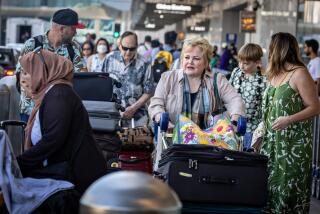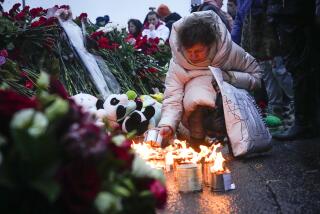Downed Russian Jets Raise Security Concerns in U.S.
- Share via
WASHINGTON — The destruction of two Russian airliners in suspected suicide bombings Aug. 24 has alarmed U.S. officials, exposing a gap in airport security that authorities here have identified but not yet closed.
“It is sort of your worst nightmare come true,” said Rep. John L. Mica (R-Fla.), chairman of the House Transportation and Infrastructure Subcommittee on Aviation. “Even though it has happened thousands of miles away, it just ushers in a whole new era of potential problems and disasters.”
A complicating factor, though, is a reluctance among some in the Bush administration and in Congress to increase the $5-billion annual aviation security budget by hundreds of millions of dollars, officials said.
On Thursday, security screeners in Moscow were supposed to begin checking passengers traveling to the United States for hidden bombs, following a directive from the U.S. Transportation Security Administration. A U.S. official said the two women suspected of carrying out the attacks over Russia each might have been wearing “some sort of body bomb.”
But those security measures do not address the danger of similar attacks on planes flying from airports in the United States, a threat that deserves “priority attention,” according to the independent Sept. 11 commission. U.S. airport screeners do not routinely check passengers for hidden explosives. Checked bags are screened for bombs; to some extent, so are carry-on articles and shoes.
“I believe that with this terrorist event, we are entering a whole new era of suicide bombers,” Mica wrote TSA chief David M. Stone on Tuesday. “These simultaneous acts of terrorism involving aircraft, if proven true, could signal the advent of copycat actions.”
In an interview, Mica said he was putting the TSA “on notice.”
A TSA spokesman, Mark Hatfield, said the agency also wanted to screen people, not just bags, for explosives. It has no timetable for meeting that objective, although it is testing various devices.
Checking for explosives should be “part of the routine of passenger screening, as opposed to just some sort of addendum,” Hatfield said.
But Mica’s Democratic counterpart on the House aviation panel said the agency and the Bush administration were “in denial on this issue.”
“They have no intention of quickly deploying bomb detection equipment to screen passengers and carry-on bags,” Rep. Peter A. DeFazio (D-Ore.) said. “What happened in Russia is the final call before we wake up to a tragedy.”
There are precedents in the recent history of terrorism.
When investigators pieced together the background of the Sept. 11 plot, they found that it grew out of a mid-1990s scheme to bomb 12 U.S. airliners as they flew over the Pacific. Known as the Manila plot, it fell apart when Philippine police raided a bomb-making factory. One of the plotters, Khalid Shaikh Mohammed, became the mastermind of the Sept. 11 attacks, U.S. authorities say. He is in U.S. custody.
TSA officials say they are aware of the threat and are working on tests of at least three kinds of technology.
Among the most promising are high-tech booths called trace detection portals, or “puffers.” They resemble medical diagnostic devices and would be installed at security checkpoints.
When a passenger steps into a booth, the device emits puffs of air that help loosen microscopic particles on the person’s body and clothing. A body’s natural heat causes the particles to rise, and they are collected and analyzed by the machine. The entire process takes about 15 seconds.
Such detection devices are being tested at five airports this year, including Lindbergh Field in San Diego. Tests at 10 more airports, possibly including Los Angeles International, are planned next year.
At a cost of $132,000 for each machine, about $240 million would be needed to equip the 1,800 security lanes at 450 commercial airports.
Another technology involves using document scanners to detect minute traces of explosives on passports, boarding passes and other papers. These have been installed at four airports, including LAX, but testing has not begun.
Finally, TSA is experimenting with a “backscatter” -- an X-ray machine that can perform a full body scan. To mitigate privacy concerns, operators might see only a human stick figure with an indicator pointing to the general area where a suspicious item is detected. A TSA spokeswoman said the agency planned to test these machines at airports, but had not set a timeline or picked locations.
In addition to technology, TSA is working on a program to train screeners how to recognize behavior patterns that might reveal a bomber, officials said.
DeFazio questioned the need for extensive testing of new technology, particularly the trace detection portals.
“We have been told in staff briefings by a senior TSA official that these machines are a mature technology,” he said. “They are being used effectively at nuclear power plants and military installations. We just need to buy them and deploy them.”
The Sept. 11 commission said that screening travelers for explosives was a reform that was “needed soon.” In the meantime, it recommended that TSA to check for explosives on each of the estimated 300,000 passengers selected each day for special screening.
The agency is resisting that recommendation, saying existing security measures are adequate. But DeFazio said a more likely explanation was that TSA did not have enough screeners to do the job without increasing the waiting time in airport security lines. Congress has capped the number of federal screeners at 45,000.
More to Read
Sign up for Essential California
The most important California stories and recommendations in your inbox every morning.
You may occasionally receive promotional content from the Los Angeles Times.










